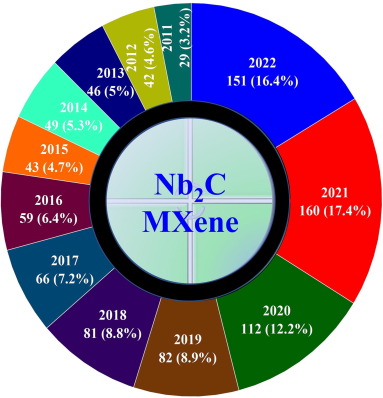
hotline:
17715390137
Tel/Wechat:
18101240246 (Technology)
0512-68565571
Email:mxenes@163.com (Sales Engineer)bkxc.bonnie@gmail.com
Scan the code to follow or search the official account on WeChat:
2D Materials Fronrier After paying attention,
click on the lower right corner to contact us,
Enter enterprise WeChat.
Professional Services Online

已传文件:photo/1687934196.png
 16879341962.png
16879341962.png
Two-dimensional niobium carbide (Nb2C), a member of the emerging MXene family, has recently garnered attention in various fields, including materials science, physics, chemistry, and nanotechnology. In this review, we highlight the material properties, synthesis strategies, and applications of Nb2C in energy storage devices, catalysis, and photovoltaic devices. We first introduce the synthesis methods, structural characteristics, and notable chemical and physical properties. Then, we discuss the influence of morphology, functional groups, and electrolytes on electrochemical energy storage devices, and present and compare advancements of various Nb2C-based batteries and supercapacitors. Next, we summarize the current progress of Nb2C MXene in electrocatalytic and photocatalytic hydrogen evolution reactions. Finally, we present the implementation of Nb2C MXene as a charge transport layer in organic and perovskite solar cells. These examples encompass diverse architectures, interface configurations, and functionalization approaches, showing a promising future for Nb2C as a rising energy material. They also inspire researchers to come up with innovative material designs to improve device performance and extend possible applications of Nb2C MXene.

Characteristic structural, optical, and electronic properties of Nb2C MXenes are described.
Recent progresses in the use of 2D Nb2C for various energy storage devices are summarized.
Design, properties, and prospects of Nb2C-based composite catalyst for hydrogen evolution reaction are explored.
The current state of synthesis methods for Nb2C MXenes are presented.

Fig. 1. The periodic table highlights the elements involved in the construction of MAX phase and MXene materials with their surface terminal groups. Each group of elements is distinguished by a different color.

Fig. 2. Chemical formulas of MAX phases and MXene phases for different known MXenes.

Fig. 3. Nb2C MXene synthesized by HF acid etching from its Nb2AlC MAX phase and resulting exfoliated nanosheets obtained using delaminating agents.

Fig. 4. The various fields of application of 2D Nb2C MXene materials.

Fig. 5. Timeline and publication count of Nb2C MXene over the past 12 years (data collected from the Web of Science).

Fig. 6. The schematic diagram illustrates the photocatalytic HER reactions using Nb2C MXene materials.
This review provides an overview of recent advances in synthetic methods and energy technologies related to emerging 2D Nb2C MXene materials. The family of MXenes was first discovered in 2011, and since then, many new types of MXenes have been synthesized and studied. Although Nb2C MXene materials were discovered as early as 2013, there has been a surge of interest in these materials in recent years. Nb2CTx has excellent conductivity and a band gap that is either close to zero or very small. In addition, the conductivity can be adjusted by the flexible combination of functional groups, making it highly applicable. The first part of the review covers the history of MXene family members, material properties, and various synthetic methods of 2D Nb2C MXene materials. The second part of the review focuses on the recent development of 2D Nb2C MXenes in energy storage devices and energy conversion technologies. Due to its unique two-dimensional layered structure, abundant surface terminations, excellent metal conductivity, and intercalation pseudocapacitance, 2D Nb2C MXene materials are instrumental in improving energy and power density in energy storage devices. We cover research on Nb2C-based electrochemical energy storage devices, including Li-ion batteries, Li-S batteries, Na-ion batteries, and supercapacitors. Hydrogen energy is an essential component of green energy, and water electrolysis is a clean source of hydrogen. However, water splitting is a non-spontaneous reaction that requires energy to start and maintain stability. The introduction of noble metal Pt into electrocatalysts can effectively improve the efficiency of water splitting, but this technology is expensive and not easily scalable. Therefore, finding alternatives to noble metal-based electrocatalysts is crucial for green energy technologies. The use of MXene catalysts is promising for electrochemical reactions, including HER, ORR, OER, and NRR. Transition metal nitrides can be used to develop outstanding electrocatalysts to replace noble metal-based electrocatalysts. This review explores recent studies on 2D Nb2C MXene materials and their heterostructures as electrocatalysts and photocatalysts. For example, researchers have confirmed that Nb2O5/C/Nb2C composite photocatalyst has excellent photocatalytic hydrogen production efficiency due to the high separation efficiency of photogenerated charge carriers at the heterojunction. Such examples show that designing and realizing new nanocomposite materials is an important direction for developing high-efficiency catalytic materials using 2D Nb2C MXene in the future.
Summary and future perspective

| Reminder: Beijing Beike New Material Technology Co., Ltd. supplies products only for scientific research, not for humans |
| All rights reserved © 2019 beijing beike new material Technology Co., Ltd 京ICP备16054715-2号 |